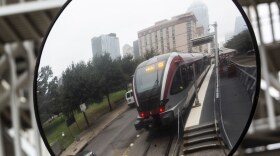Less than two years into the single-largest expansion of public transit in Austin's history, costs have already ballooned by at least 40% and now rest somewhere above the $10 billion mark.
Transit planners are vowing to complete the Project Connect plan voters approved in November 2020 and have a "working expectation" of no new tax increases, according to an internal memo from Project Connect's Dave Couch, but the possibility has not been ruled out entirely.
The local portion of Project Connect, a bit more than half the cost, is funded by a voter-approved 20% increase in the city's property tax rate.
Planners intend to complete the project by adjusting the timing; some parts might take longer to build as planners wait for more tax revenue to come in from the 8.75 cents per $100 of property value dedicated to the transit expansion.
"The Project Connect team remains fully committed to fulfilling the promise to build the program voters approved in November 2020," spokesperson Tawaun Cole said in a statement.
The transit expansion, once complete, will sharply increase the capacity of major streets in Austin by allowing people to catch frequent light-rail trains and electric buses capable of transporting hundreds more people per hour than cars and trucks. The project will require reshaping major streets to prioritize transit over cars.

What's driving costs higher? Two major factors: price inflation on everything from construction materials to real estate and changes to the design.
Let's start with the basics.
Project Connect includes two light-rail routes. The Orange Line will connect North and South Austin. The Blue Line will run from Austin-Bergstrom International Airport through Southeast Austin and into downtown.
A downtown subway tunnel, a new commuter rail line to East Austin's Colony Park, an expansion of existing commuter rail and four new high-frequency bus routes also make up the project.
The light-rail and subway tunnel, the most expensive components of the plan, are pushing costs highest.
The tunnel was first estimated to cost $2 billion but has now more than doubled to $4.1 billion. That's because the length has more than doubled.
Flood risks, the slope of the hill leading into South Austin and other technical factors pushed designers to increase the tunnel's length from 1.56 miles to 4.19 miles.

Extending the subway tunnel from Third Street downtown to Live Oak Street at South Congress requires putting two more stations underground: The Orange Line station at Auditorium Shores and the station at South Congress will be subterranean.
On top of that, the Blue Line tunnel planned to run along Fourth Street in downtown Austin now includes an underground station at Congress Avenue and a pedestrian concourse that would let people walk underground along the tunnel's length.

Other costly changes to Project Connect include extending Dean Keaton Street to San Antonio Street, so cars have somewhere to turn when traffic is restricted from Guadalupe. That plus changes to the design of a bridge over Lady Bird Lake, drainage and water management requirements and other adjustments added another $450 million to the total.

The cost of relocating utilities alone grew by $260 million.
"Many of these increases are from the community input process and collaboration on the technical design and requirements with all three parties," Couch explained in the memo.
Inflation has also taken a bite out of the Project Connect budget.
A surge in real estate prices is pushing up the cost of seizing land through eminent domain for the right of way. The median sales price for a home in Austin is up 15% in the last year to $565,000, according to the Austin Board of Realtors.
Early estimates budgeted $250 million for land acquisition for the Orange and Blue Lines. That has now grown to $1.19 billion.

Less costly parts of Project Connect are still on budget, according to Couch's memo. The high-frequency bus routes, MetroRapid, were awarded an additional $500,000 in federal grants. That money is going back into the main fund for Project Connect.
Expanding the commuter rail line MetroRail is on schedule and on budget, Couch said. The next big step is a groundbreaking on a new MetroRail station planned for July at McKalla Place near Q2 Stadium.



























